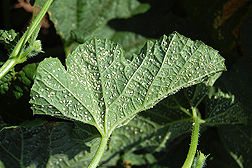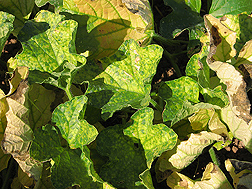Protecting Our Melons
Combating Cucurbit Yellow Stunting Disorder Virus
|
|
Much of our country’s popular cucurbit crops, like cantaloupe and honeydew, are grown in California’s Imperial Valley and nearby Yuma, Arizona. But a few years ago, growers in the area noticed a new disease spreading through their fields.
Agricultural Research Service plant pathologist Bill Wintermantel, with the U.S. Agricultural Research Station in Salinas, California, and university colleagues were asked to help identify the disease. The diagnosis: cucurbit yellow stunting disorder virus, or CYSDV.
CYSDV, a “crinivirus” originally from the Middle East, was identified by Wintermantel and colleagues in the melon-production regions of California, Arizona, and Sonora, Mexico, in the fall of 2006. Wintermantel and Florida colleagues also identified CYSDV a year later in that state.
“It’s difficult to determine exactly how the virus spread to California and Florida, but it’s clearly the same virus in both locations,” says Wintermantel. “Virus samples from both regions indicate they are essentially genetically identical to one another.”
Melons from plants infected with CYSDV may appear normal but often have reduced sugar levels, resulting in poor marketability. The virus is spread by the whitefly, Bemisia tabaci, a small sap-sucking insect.
Wintermantel and colleagues identified several local weeds and important alternate crops, such as alfalfa, lettuce, and snap beans, as hosts of CYSDV. They found that the virus is capable of infecting plants in seven plant families besides the Cucurbitaceae family. The scientists are now trying to determine which of the new host plants are most important for virus survival during noncropping seasons and to better understand how the virus is moving throughout the region.
Meanwhile, horticulturist Jim McCreight, research leader of the Salinas laboratory, is working to develop CYSDV-resistant melons. In 2006, when the disease first appeared in California, McCreight observed resistance in a salad melon (a nonsweet melon similar to a cucumber) from India that was being grown for research purposes in Yuma and in the Imperial Valley. McCreight also determined that a salad melon from Africa—first reported by Spanish investigators as resistant to a strain of CYSDV present in southern Spain—was resistant to CYSDV in California and Arizona. After field screening of more than 300 melon accessions from India, McCreight found a few plants among them showing promise of resistance to the virus. He continues to evaluate these lines and additional material sent from overseas.
|
|
McCreight’s field tests showed that disease resistance can only be effective when whitefly populations are controlled. “The whiteflies and the virus are like a severe one-two punch to the plant,” says McCreight. “Hundreds of whiteflies constantly feeding on the plants assure high frequency of infection by the virus. Continued heavy feeding by the whiteflies, particularly in summer-planted melons grown in high temperatures, further weakens the plants. The result is often complete loss of fruit yield and quality or plant death.”
For genetic resistance to be truly effective for preventing crop losses, it will be necessary to combine it with effective pest-management practices. With further research, the scientists hope to develop a plan to combat this devastating disease.—By Stephanie Yao, formerly with ARS.
This research is part of Plant Genetic Resources, Genomics, and Genetic Improvement (#301) and Plant Diseases (#303), two ARS national programs described at www.nps.ars.usda.gov.
Bill Wintermantel and Jim McCreight are with the USDA-ARS U.S. Agricultural Research Station, 1636 East Alisal St., Salinas, CA 93905; (831) 755-2824 [Wintermantel], (831) 755-2864 [McCreight].
"Protecting Our Melons: Combating Cucurbit Yellow Stunting Disorder Virus" was published in the March 2011 issue of Agricultural Research magazine.









